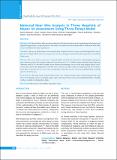Please use this identifier to cite or link to this item:
https://hdl.handle.net/20.500.14356/1099Full metadata record
| DC Field | Value | Language |
|---|---|---|
| dc.contributor.author | Maharjan, Nashna | - |
| dc.contributor.author | Tuladhar, Heera | - |
| dc.contributor.author | Malla, Kasturi | - |
| dc.contributor.author | Tumbahangphe, Kirtiman | - |
| dc.contributor.author | Budhathoki, Bharat | - |
| dc.contributor.author | Karkee, Rajendra | - |
| dc.contributor.author | Shrestha, Jyoti Raj | - |
| dc.contributor.author | Merriel, Abi | - |
| dc.contributor.author | Manandhar, Dharma Sharna | - |
| dc.date.accessioned | 2023-04-24T05:42:49Z | - |
| dc.date.available | 2023-04-24T05:42:49Z | - |
| dc.date.issued | 2021 | - |
| dc.identifier.citation | MaharjanN., TuladharH., MallaK., Kirtiman Tumbahangphe, BudhathokiB., KarkeeR., ShresthaJ. R., MerrielA., & ManandharD. S. (2021). Maternal Near Miss Analysis in Three Hospitals of Nepal: An Assessment Using Three Delays Model. Journal of Nepal Health Research Council, 19(2), 264-269. https://doi.org/10.33314/jnhrc.v19i2.3322 | en_US |
| dc.identifier.issn | Print ISSN: 1727-5482; Online ISSN: 1999-6217 | - |
| dc.identifier.uri | http://103.69.126.140:8080/handle/20.500.14356/1099 | - |
| dc.description | Original Article | en_US |
| dc.description.abstract | Abstract Background: Maternal Near Miss cases have similarities with those dying from such complications and so present an important opportunity to improve practice. This study was conducted to assess the prevalence of Maternal Near Miss events and identify the delays experienced. Methods: This was a facility-based cross-sectional study conducted in three tertiary referral hospitals from three provinces of Nepal. All the women surviving a near miss event during six months data collection period were included in the study. Results: There were 67 near miss cases, 7 maternal deaths, and 9158 live births in the study hospitals during the data collection period. This resulted in Maternal Near Miss ratio of 7.31/1000 live births and facility-based Maternal Mortality Ratio of 76/100,000 live births. Severe obstetric haemorrhage (54%) was the most frequent clinical cause of near miss, followed by hypertensive disorders (43%). At least one type of delay was experienced by 85% women. First delay occurred in 63% (42 of 67) cases, second delay occurred in 52% (33 of 62) cases and third delay occurred in 55% (37 of 67) cases. Conclusions: This study found out that all three delays were common among women experiencing maternal near miss event. Raising awareness regarding dangers signs, improving referral system and strengthening ability of health workers can help in reducing these delays. Keywords: Maternal near miss; MNM; Nepal; three delays | en_US |
| dc.language.iso | en | en_US |
| dc.publisher | Nepal Health Research Council | en_US |
| dc.relation.ispartofseries | Apr-June, 2021;3322 | - |
| dc.subject | Maternal near miss | en_US |
| dc.subject | MNM | en_US |
| dc.subject | Nepal | en_US |
| dc.subject | three delays | en_US |
| dc.title | Maternal Near Miss Analysis in Three Hospitals of Nepal: An Assessment Using Three Delays Model | en_US |
| dc.type | Journal Article | en_US |
| local.journal.category | Original Article | - |
| Appears in Collections: | Vol. 19 No. 2 (2021): Vol 19 No 2 Issue 51 Apr-Jun 2021 | |
Files in This Item:
| File | Description | Size | Format | |
|---|---|---|---|---|
| 3322-Manuscript-23761-1-10-20210907.pdf | Fulltext Download | 294.93 kB | Adobe PDF |  View/Open |
Items in DSpace are protected by copyright, with all rights reserved, unless otherwise indicated.
